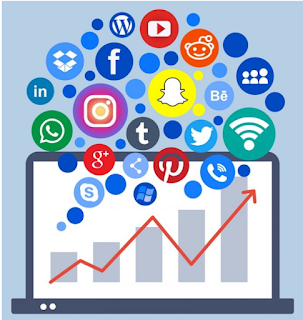What is digital marketing and how does it guides digital marketer :
When a product or service is advertised online, via social
media, mobile devices, or any other digital medium utilizing online marketing
techniques, it is called digital marketing.
Social Media Marketing, Search Engine Optimization, and
Email Marketing are all examples of this umbrella phrase.
In contrast to print, billboards, and television, the digital
marketing sector is heavily reliant on data. Campaign reports, available on a slew of
prominent digital advertising platforms, allow for in-depth data analysis.
Digital Marketers today are able to gather and analyze data
of diverse consumer behavior or user interactions, which enables them to allow
more personalized content and adverts targeting precisely defined audiences for
greater engagement and outcomes, thanks to the internet and technology.
How many types of digital marketing platforms :
- Social Media Marketing (SMM)
- Search Engine Optimization (SEO)
- Email Marketing
- Content Marketing
Let’s have a brief discussion of each point.
SEO (Search Engine Optimization)
You turn to Google first and foremost whenever you have a
question or desire to make a purchase. The first or second page of Google
search results generally contains the results that a user is looking for.
SEO comes into play here. SEO-friendly web design is a
critical component of every successful online campaign. Unless your website is
optimized for search engines, you will be unable to attract new customers and
get visibility for your business.
For those who don't want to spend money to get their website on the first page of Google's search engine results, SEO is the best option. SEO is a no-cost strategy that progressively builds up a site's traffic over time.
Social media
marketing
Social media marketing is one of the most popular and efficient kinds of digital marketing is the use of. Social media has revolutionized corporate marketing in a way that no other medium has ever been able to do.
It's incredible how much exposure your business may get from
the ever-increasing number of social media users all around the world. You
won't be slinging darts into the dark for marketing success when you have
access to so much customer behavior data.
Consider social media marketing for your business by reading
our blog post on how social media has altered marketing.
As a business owner, social media is your best bet for promoting your products and services while keeping in touch with your potential clients. Additionally, you may utilize social media to run advertising campaigns, and contests, develop innovative and interesting content, and even go viral.
Using Email for
Promotion (Email Marketing)
It's estimated that people check their mail an average of 15
times a day, but this figure might be far higher.
For most businesses, email marketing isn't the major source
of new leads, but rather a way to communicate with customers who have expressed
interest in your products or services and have signed up to receive your
business updates.
Email marketing increases your chances of acquiring
consumers who are repeat buyers. Weekly newsletters, promotional offers, and
information about new products and services are all common uses for email
marketing.
Content Marketing
It's all about the content.
An important role for content marketing may be found in
online advertising. Without content marketing, you won't be able to establish a
customer base, brand, or engage your target audience into being interested in
your business.
To put it simply, content marketing is all about engaging with your consumers and persuading them to buy from you. Videos, testimonials, ebooks, podcasts, infographics, blogs, and social media postings are just a few examples of content marketing.
Digital Marketing Goals :
Why digital marketing is important :
As part of your digital marketing strategy, you may use all
of these to create customer awareness of your brand.
We've learned a lot about the benefits of digital marketing thus far, including what it is, how it works, and the numerous tools firms use.
Create a plan specifically designed for the demands of your digital business if you want to make the best digital marketing work for you. There is no one-size-fits-all approach to internet marketing.
Learn the Online Marketing that Gets Real Results :
It's possible to employ a few or all of these tools in combination for your digital marketing campaign based on your business category, your target demographic, and your business goals. With the correct digital marketing strategy, you will be able to draw in your target market, raise awareness, keep them interested, and reduce their buying cycle.
The complete digital marketing guide help always expands interest for talented computerized advertisers, there are a lot of chances out there for experts hoping to get into the field. Assuming you are one of them, first, you want to comprehend that computerized showcasing is a wide field, and there are a lot of roads to look over on the off chance that you enter it. Coders, Data Science experts, scholars, visual architects, and video editors can make a shift to advanced advertising professions.
.jpg)
.jpg)














